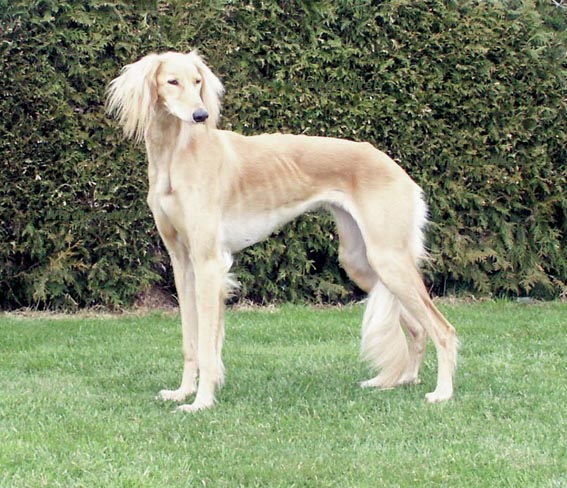
The Breed History
This breed is thought to be one of the most ancient breeds of
domesticated dogs. Excavations of ancient settlements (6500 BC,
Sumerian empire), and Egyptian tomb carvings of 2100 BC reflect
the presence of a distinctly "Saluki type" dog. They were highly
esteemed and mummified remains of this type of dog have been
found, attesting to their important status in Egyptian society.
Muslim religion classed dogs as unclean, and termed them kelb but
the Saluki on the other hand, was termed the "noble one" or El Hor,
and accorded sacred status.
Originating in the region that includes Egypt, Arabia, Syria
and Persia, and accompanying the Bedouin tribes, the first
specimens were brought to England in the year 1840. The smooth
(non-feathered) variety of Saluki is very much like the Sloughi dog.
The latter was thought to have originated from the town of Saloug
in Yemen. The Saluki likely originated in the town of Saluk, Yemen.
The AKC recognized this breed in 1927.
Breeding for Function
Because of the harsh climate in which these dogs were kept, they
became hardy and tolerated temperature extremes. They were also
particularly sure-footed in rough going. Their speed, agility and
endurance allowed them to hunt all day over difficult terrain. Arabs
used these dogs to hunt gazelle, though they were also capable
hunters of foxes, wild boar, and hares. In Europe and England
the sport of saluki racing (which required clearing hurdles) was
undertaken. They are found nowadays mostly in companionship
and lure coursing or open field coursing roles.
Physical Characteristics
Height at Withers: female 22-26" (56-66 cm), male 23-28"
(58.5-71 cm)
Weight: females 31-40 lb (14-18 kg), males 40-55 lb (18-25 kg).
Coat: Their coat is fine and silky, shorter over the body and
well-developed feathers are present. Colors include white, cream,
golden, red, fawn, grizzle and tan, black-and-tan, and tri-color. A
smooth variety of this breed has the same body coat but without
the feathers.
Longevity: 12 years
Points of Conformation: Long, with a very lean athletic build,
exceptionally smooth and graceful bounding movements
characterize Saluki dogs. Their ability to accelerate very quickly to
speed allows them to be effective in gazelle hunts. The skull is long
and narrow, the stop is not very pronounced, and the nose is either
black or liver colored. The eyes are large, oval and colored dark
brown to hazel. The ears are long, pendulous and fine-leathered
with very long feathers. The neck is long and muscular, the thorax is
somewhat narrow but very deep. The legs are straight and long. Tarsi
are placed low on the hind limb. Feet are moderately arched, with
good feathering between the toes. The inner digits can be longer
than the outer digits. The tail is long, tapering, feathered on the
underside, and carried in a curve. The back is broad with a slightly
arched loin. They normally have prominent hip bones and the caudal
rib cage is also clearly evident when they are in fit condition.
Recognized Behavior Issues and Traits
Reported breed characteristics include: Very athletic, and require
lots of exercise and activity, friendly, clean, and they enjoy a soft
bed inside the home. Saluki dogs are intelligent. Training should be
started early, and socialization should be emphasized to counteract
any nervous or shy/high strung tendencies. Introduce them to
children, small dogs and household cats early. They thrive on close
human companionship. They are sensitive, and obedience training
is strongly recommended. Free exercise should only occur in a
high fenced enclosure. They are somewhat independent minded.
Though they do not like fetch type activities, they love to chase, so
care should be taken to keep small animals such as cats out of their
reach. Destructive behavior can occur if they become bored. Their
coat has average care needs and they are average shedders. They will
alarm bark, but are not considered defense dogs. Some recommend
a snood, or ear hood to help prevent soiling of hair at mealtime.
Normal Physiologic Variations
Thyroid Hormone Levels: Sighthounds have lower normal ranges
for T4 and T3 concentrations compared to other breeds. Median
(reference limits) serum concentrations in Salukis are:
Total T(4): 13.0 nmol/L (2.8 to 40.0 nmol/L)
Free T(4): 12.0 pmol/L (2.0 to 30.3 pmol/L)
Total T(3): 1.0 nmol/L (0.4 to 2.1 nmol/L)
Free T(3): 4.0 pmol/L (1.6 to 7.7 pmol/L)
TSH: 0.18 ng/mL (0 to 0.86 ng/mL)
Drug Sensitivities
Anesthesia: Sight hounds require particular attention during
anesthesia. Their lean body conformation with high surface-area-tovolume
ratio predisposes them to hypothermia during anesthesia.
Impaired biotransformation of drugs by the liver results in prolonged
recovery from barbiturate and thiobarbiturate intravenous
anesthetics. Propofol, and ketamine/diazepam combination are
recommended induction agents.
Inherited Diseases
Hip Dysplasia: Polygenically inherited trait causing degenerative
joint disease and hip arthritis. OFA reports 1.6% affected.
Elbow Dysplasia: Polygenically inherited trait causing elbow
arthritis. Too few Salukis have been screened by OFA to determine
an accurate frequency.
Patella Luxation: Polygenically inherited laxity of patellar
ligaments, causing luxation, lameness, and later degenerative joint
disease. Treat surgically if causing clinical signs. Too few Salukis
have been screened by OFA to determine an accurate frequency.
Disease Predispositions
Mitral Valve Disease (MVD): Salukis are reported with a high
incidence of mitral regurgitation and thickening of the mitral
valve. This condition can lead to congestive heart disease, cardiac
arrhythmias (irregular heart beats) and cardiac failure. Unknown
mode of inheritance. Reported as a breed problem in the 2000 SHR
Inc. Saluki Health Survey.
Hypothyroidism: Inherited autoimmune thyroiditis. 12.8% positive
for thyroid autoantibodies based on testing at Michigan State
University. (Ave. for all breeds is 7.5%).
Persistent Pupillary Membranes: Strands of fetal remnant
connecting; iris to iris, cornea, lens, or involving sheets of tissue.
The later three forms can impair vision, and dogs affected with
these forms should not be bred. Identified in 6.41% of Salukis CERF
examined by veterinary ophthalmologists between 2000-2005.
Cataracts: Nuclear intermediate and punctate cataracts
predominate in the breed. Identified in 3.91% of Salukis CERF
examined by veterinary ophthalmologists between 2000-2005.
CERF does not recommend breeding any Saluki with a cataract.
Vitreous Degeneration: A liquefaction of the vitreous gel which
may predispose to retinal detachment resulting in blindness.
Identified in 2.56% of Salukis CERF examined by veterinary
ophthalmologists between 2000-2005.
Cardiac Hemangiosarcoma/Sudden Death: In a necropsy study
of Salukis with sudden death, 31% had cardiac hemangiosarcoma.
The Saluki is found to have a 1% incidence of this type of cancer,
with a 7.75x odds ratio of developing it versus other breeds. Almost
one-third of all cases of cardiac hemangiosarcoma in dogs occur in
Salukis. Unknown mode of inheritance. Reported as a breed problem
in the 2000 SHR Inc. Saluki Health Survey.
Immune-Mediated Hemolytic Anemia (IMHA): Autoimmune
destruction of red blood cells. Treat with immunosuppressive drugs.
Unknown mode of inheritance. Reported as a breed problem in the
2000 SHR Inc. Saluki Health Survey.
Black Hair Follicular Dysplasia: Reported in Salukis in the UK.
Loss of black hairs beginning around 4 weeks of age. Total loss of
all black hair by 6-9 months of age. Melatonin may be effective.
Unknown mode of inheritance.
Ceroid Lipofuscinosis: Rare, fatal degenerative neurological
disease. Onset 1-2 years. Unknown mode of inheritance.
Brachygnathism, Color Dilution Alopecia, and Prognathism, are
reported.
Isolated Case Studies
Motor Neuron Abiotrophy: A nine-week-old saluki puppy
presented for progressive, generalized weakness and bilateral
forelimb deformities. Histopathology revealed a diffuse,
symmetrical, degenerative motor neuronopathy of the ventral horn
of the spinal cord.
Multiple Cardiac Anomalies: A family of Salukis was identified
where all affected dogs had patent ductus arteriosus or ductus
diverticulum, and some members additionally had tricuspid valve
insufficiency, pulmonic stenosis, or mitral valve insufficiency.
Pedigree evaluation suggested a genetic cause.
Intersex: A litter of five salukis was presented in which all of
the individuals were intersexes or hermaphrodites. The external
genitalia resembled a combination of penile sheath and vulva, and
scrotal sacs. Internal anatomy consisted of two gonads in a position
expected for ovaries, oviducts, uterus and cord-like structures
lateral to the uterus which extended from gonad to inside of the
scrotal sacs. Histologically, the gonads appeared to be ovaries which
contained many dysgenic follicles.
Genetic Tests
Tests of Genotype: Genetic tests for coat color and length are
available from VetGen and HealthGene.
Tests of Phenotype: Recommended testing includes hip and elbow
radiographs, CERF eye examination, cardiac evaluation, patella
examination, and thyroid profile including autoantibodies.
Miscellaneous
- Breed name synonyms: Persian Greyhound (historical), Gazelle
Hound, Arabian Hound, Saluqi, El Hor (Arabic for "the noble one").
- Registries: AKC, UKC, CKC, KCGB (Kennel Club of Great Britain),
ANKC (Australian National Kennel Club), NKC (National Kennel Club).
- AKC rank (year 2008): 118 (280 dogs registered)
- Internet resources: Saluki Club of America: www.salukiclub.org
Saluki Club of Canada: www.salukicanada.com
Saluki or Gazelle Hound Club of the U.K.: www.salukiclub.co.uk
Saluki Health Research: www.salukihealthresearch.com
Photo Gallery of Breed - Saluki - Dog Breed
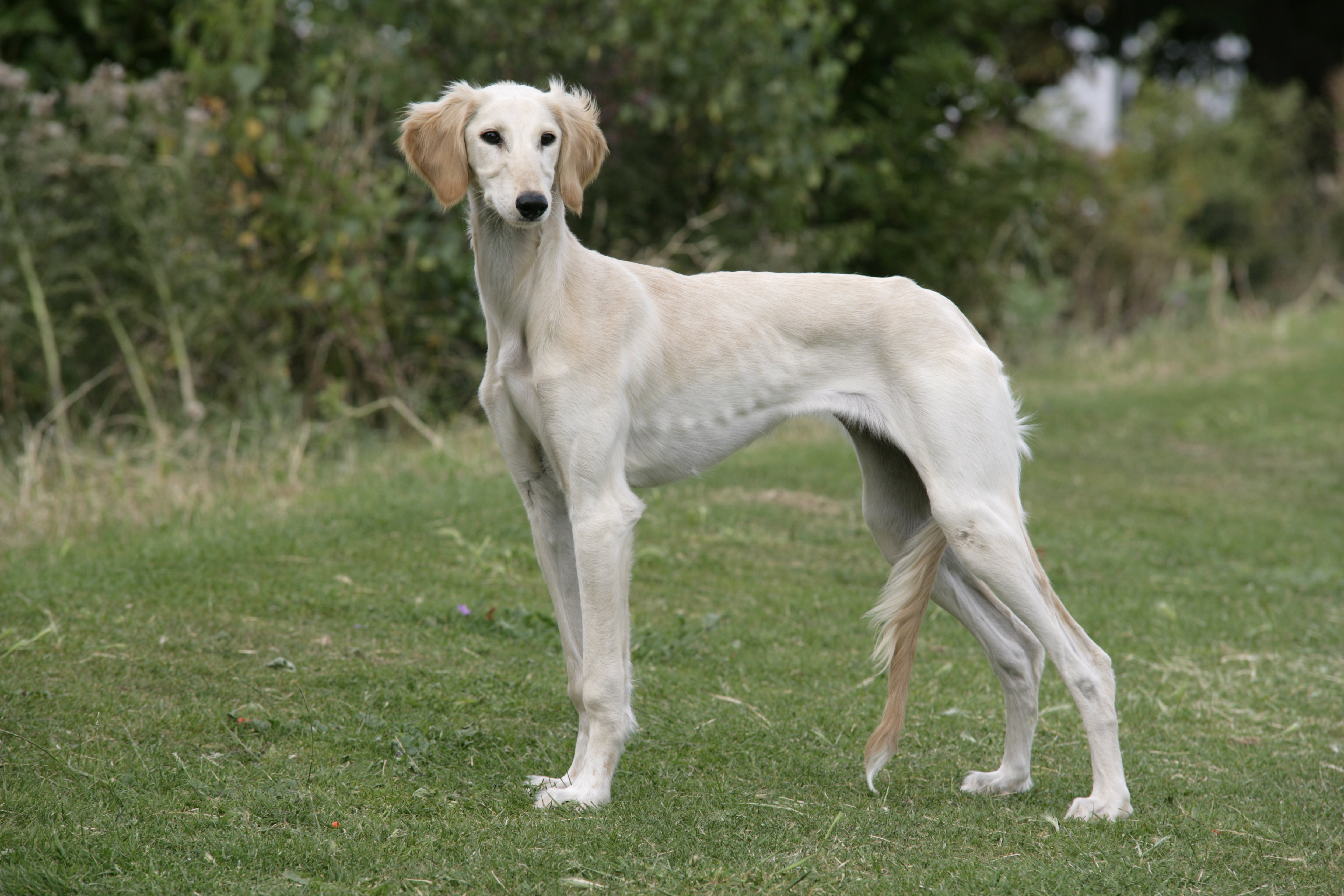


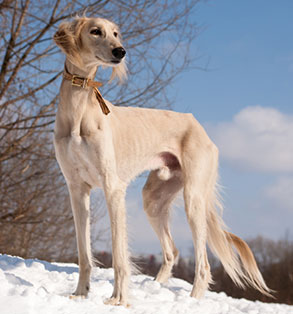
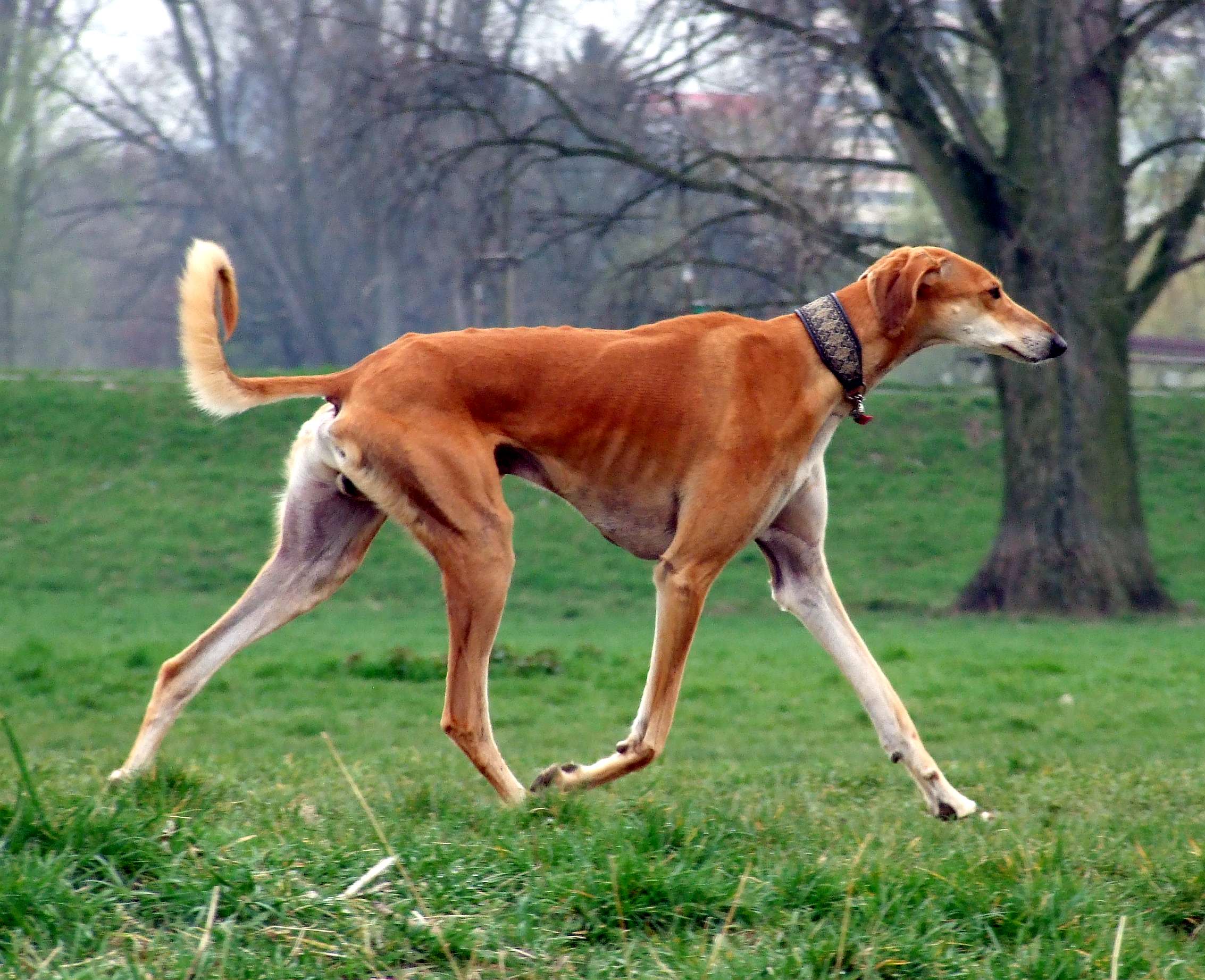
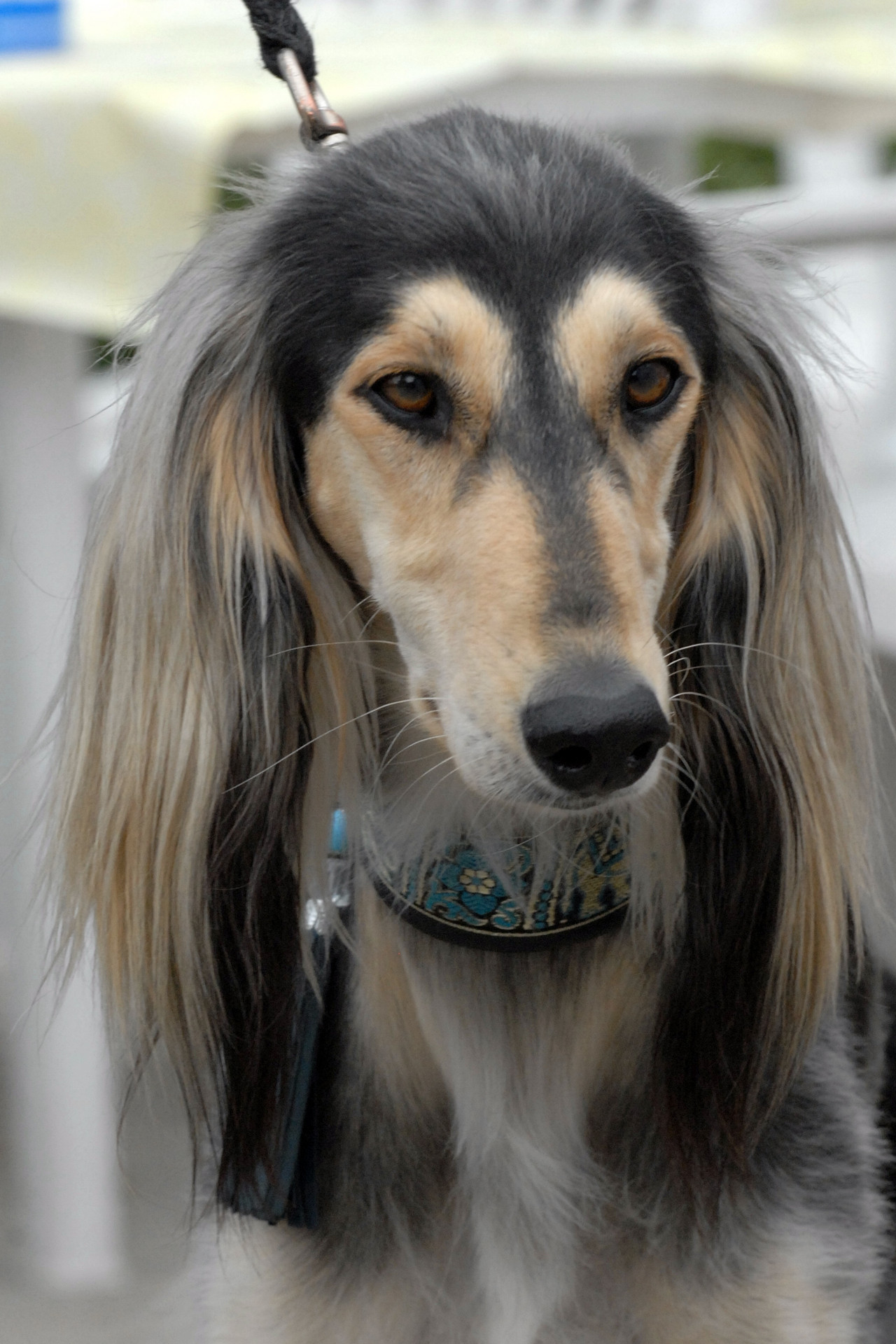
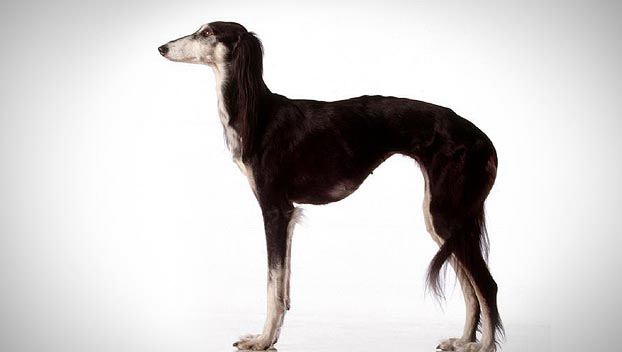
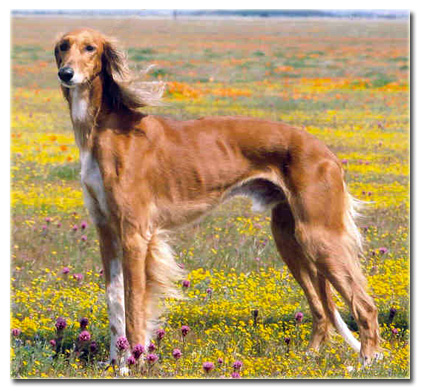
 Animalia Life
Animalia Life